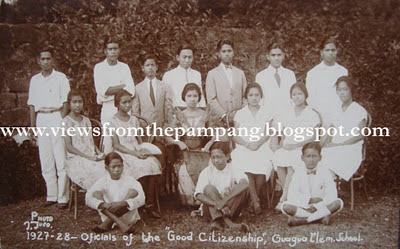 IN THOUGHTS, IN WORDS, AND IN DEEDS. Officials of the "Good Citizenship" for 1927-28. Guagua Elementary School, Guagua, Pampanga.
IN THOUGHTS, IN WORDS, AND IN DEEDS. Officials of the "Good Citizenship" for 1927-28. Guagua Elementary School, Guagua, Pampanga.The earliest memory of my school days were the flag ceremonies that were held every morning without fail—exactly at 7 a.m. , at the courtyard of our elementary school. There we were herded every day, in two lines, and, with the motion of a teacher’s hand, we stood in attention to attempt to sing the “Pambansang Awit”, as the Philippine tri-color was solemnly raised. Afterwards, a senior elementary student led us in reciting the patriotic pledge that began with “Iniibig ko ang Pilipinas..”. There was absolutely no talking and no moving about the whole time the 15 minute ceremony was conducted, which behooved many of us 6 year old first graders—we didn’t even have the lyrics of the national anthem memorized---all we knew was that we had to keep still lest we get an icy stare from our teacher.
Only later did we learn that we had just taken part in the first step towards building good citizenship; by singing our national hymn and pledging our allegiance to the country, we affirmed our status as proud and free citizens of the Philippines. The next few years, more acts of good citizenship were to be demanded from us – at home, in school, and the community in which we lived.
A whole course was taught in Grade 5 and 6, to instill in us how a good Filipino citizen should act. It began with lectures on our rights and duties as citizens—including the four freedoms—freedom of speech, religion, fear and want. Similarly, we were told of our right to vote—and we put this to good use when we started voting for our class officers. With my excellent penmanship, I was a shoo-in for the position of Class Secretary, a post I held until graduation. I never did get the Presidential post, but at least the whole class got to see my handwriting on the bulletin board.
Many schools, in fact, went beyond including Good Citizenship subjects in its curriculum but also organized clubs that promoted the basic principle that the child is a citizen and that from his earliest years, he must be given training and should undergo experiences in citizenship living. Members of the club were encouraged to attend community activities and sit in local barrio meetings so they will be in the know insofar as community issues and interests are concerned.
Goodness how many civic activities we planned, organized and actively participated in! We made posters and slogans to support our community health drives. To demonstrate self-reliance, we had our own Green Revolution project right in our own high school, planting all sorts of vegetables in vacant lots that we quickly transformed into a green garden patch. I remember also a composting project—our early contribution to recycling. In college, we were required to have at least 24 hours of community work under the “CivAc” course, which was integrated in our R.O.T.C. military training. Most of these entailed cleaning the neighborhood—hauling and collecting trash, repainting graffiti-covered walls and planting of trees.
It is good to know that teaching good citizenship continues today, under “Sibika”. Developing a civic conscience is difficult in an age where self-centeredness seem to be the trait of this “I-me-mine generation”. Only when all of us consciously and actively seek to take part in the affairs of our country, work for the welfare of our community and practice in our individual lives the highest civic and moral standards can we finally say that we are indeed Filipinos, “sa isip, sa salita at sa gawa.”






























